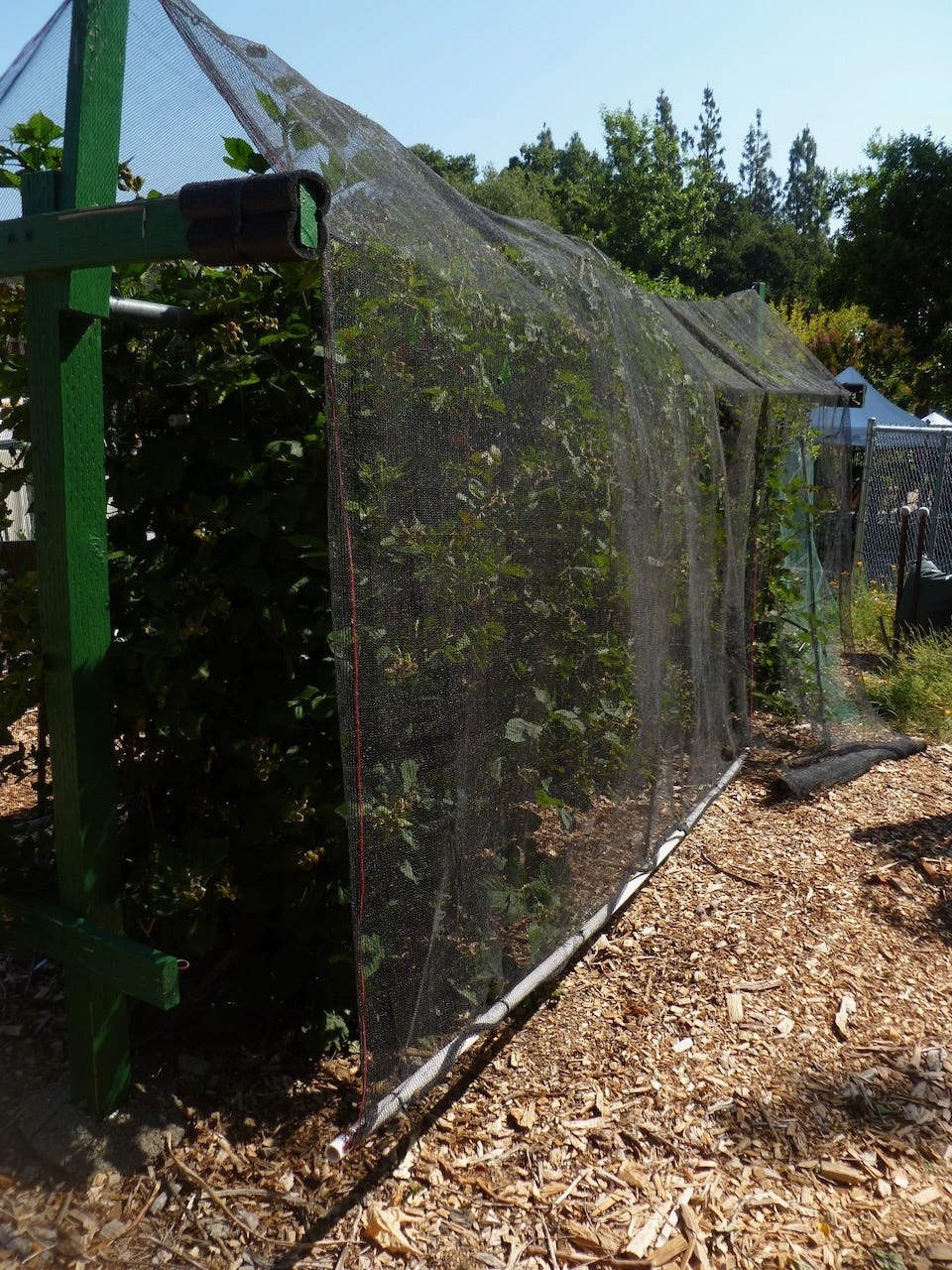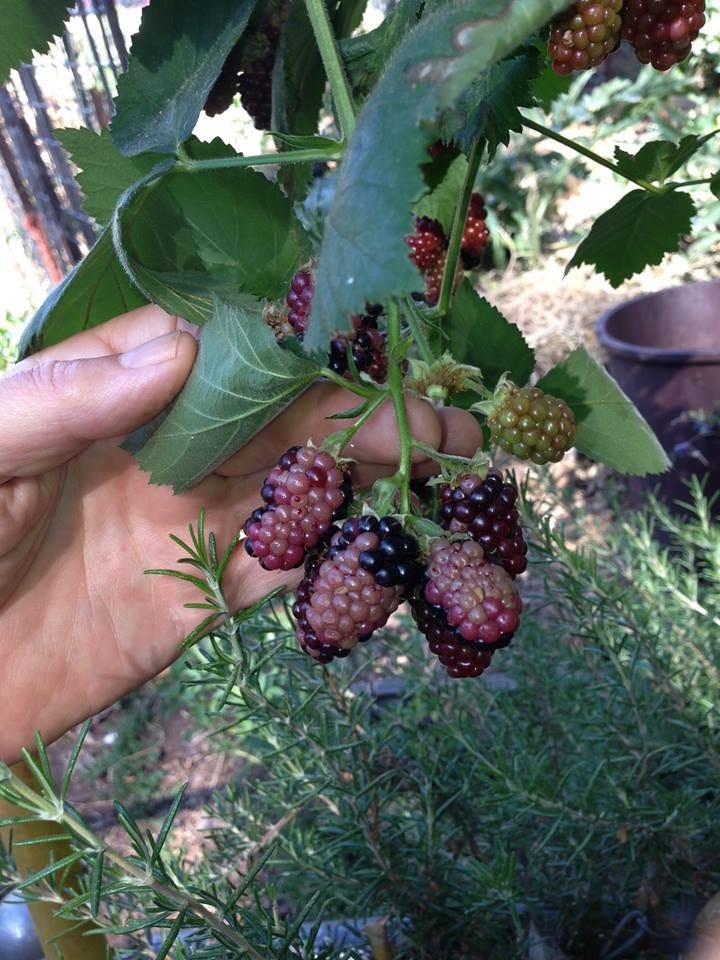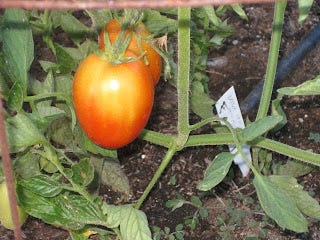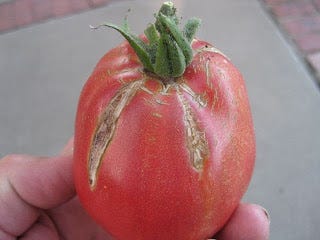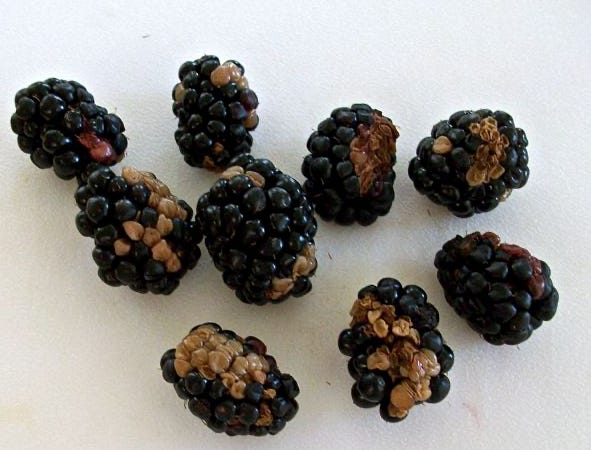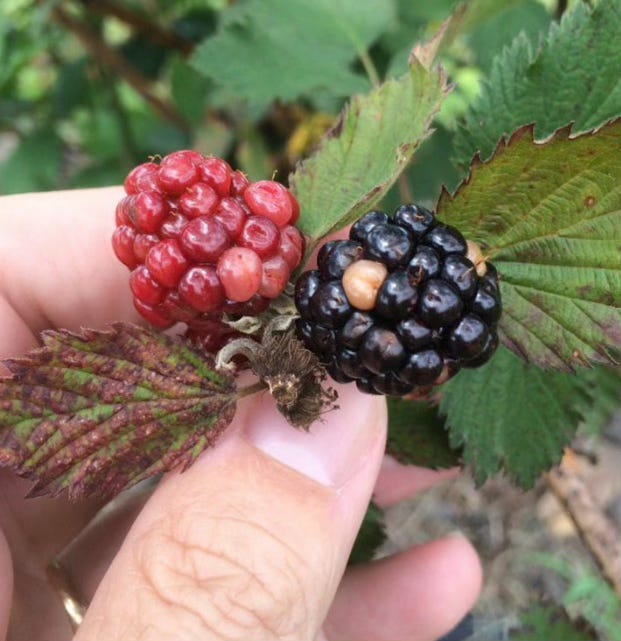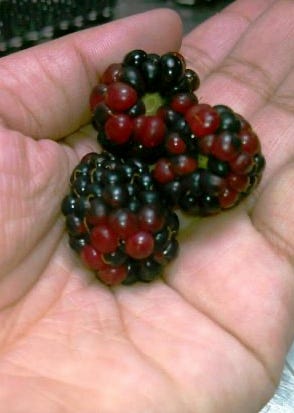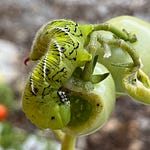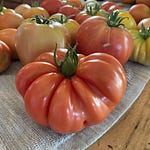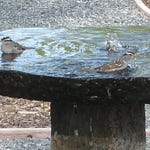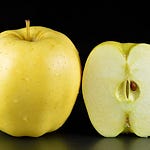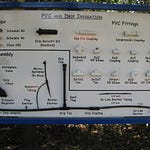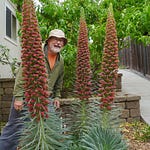If you’re wondering about blackberry discoloration this summer, you won’t find that information in the podcast (above). What you will find for your ears: great information about superior blackberry varieties to grow, along with tips for pruning and trellising blackberries.
As to why you might start seeing some discoloration in your blackberry patch right now might be due to the weather.
But before we shine a light on that, here’s what you may have missed in last Friday’s Garden Basics with Farmer Fred podcast, Ep. 349: “Stressed? Your Garden Can Help.” And haven’t we all seen an increase in the stress levels this past couple of weeks. One easy way to soothe the worried mind: single malt Scotch Take a whiff of the garden. Really!
America’s Favorite Retired College Horticulture Professor, Debbie Flower, and myself sniff out the answers that may be in your own yard.
• Gardening and spending time in nature can help reduce stress and anxiety.
• Forest bathing, or enjoying a slow walk or sit in a natural environment, can have calming effects.
• Having a garden or indoor plants can provide stress relief and improve mental well-being.
• Aromatic plants, such as jasmine, lavender, and mint, can have a soothing effect on the mind and body.
Why Are the Blackberries Turning White?
From the garden e-mail bag, Teri asks: "What is wrong with my blackberries?"
Dewey & Ann write: "What is causing this problem with my Chester blackberries? This is on the majority of them. I had it last year too. I checked with the local Hmong community farmers, and they also had it and said it was the 111 degrees we had in Oroville. We are at 2500 feet and 10 degrees cooler, but it wasn’t this hot last year. My Black Satin Blackberries were forming and doing well and I thought the problem was only with the Chester. Well, pretty soon I see it on them also. Am I missing something in our soil? It’s not on every one of them. It’s a dried seed eventually, but goes from a pink to beige and then worse if you don’t pick them. I would like to get to bottom of this. Can you help me?"
Your local Hmong are wise horticulturists. The recent week of very sunny 100+ temperatures, along with several of triple digit scorchers in the first week of July, could very well be the culprit.
Usually when we think of heat stressed plants, the cool season ones that tend to croak when it gets hot come to mind, such as lettuce plants in early summer or snow pea vines by Memorial Day weekend.
Even warm season vegetables that like sunlight, especially tomatoes, can be adversely effected by too much high intensity sun. Abiotic disorders such as cracking, solar yellowing or green shoulders are common this time of year on young tomato crops.
One remedy for those tomatoes: don't prune off any of the leaf canopy of tomato plants; or, cover with a lightweight row cover to provide some more shade.
And now, you can add blackberries to the list of crops that develop problems when it gets too sunny, too hot, dry and windy, especially because of extended heatwaves. The problem is known as White Drupelet Disorder (WDD).
According to the UC Integrated Pest Management Guidelines for Caneberries:
"White drupelet is a tan-to-white discoloration of one to many drupelets on the fruit. Most often, white drupelets will appear when there has been an abrupt increase in temperature accompanied by a drop in humidity; it is especially pronounced when there is wind. In the Monterey Bay area, white drupelet typically occurs when temperatures that are fairly steady around 70 degrees suddenly go above 90 degrees, and there is an absence of fog.
While white drupelets may seem to be directly caused by weather, they are actually caused by ultra-violet (UV) radiation. Weather conditions modulate this by the effect they have on penetration of UV radiation into the fruit. Cool, humid air scatters and absorbs UV radiation, while hot dry air has the opposite effect and allows more direct UV rays to reach the fruit. The movement of humidity away from the canopy by wind only heightens the effect of hot dry air. Additionally, as humidity is moved away from the plant canopy, more UV rays penetrate the canopy and damage fruit that may not even have been exposed to the sun. Fruit inside of the canopy is not acclimatized to UV radiation and is subsequently more susceptible when it reaches them.
Some growers of caneberries in the Willamette Valley of Oregon, where rapid changes from a normally mild climate to temperatures up to and above 100 degrees occur through the summer, use overhead irrigation to minimize fruit loss to white drupelet. This is not merely to mist the fruit; instead, large amounts of water are applied to thoroughly wet the canopy and maintain cool temperatures and high canopy humidity for as long as possible. Sprinkling is not done too late in the evening to allow fruit to dry before nightfall.
While some varieties, such as Apache blackberry, Kiowa blackberry, and Caroline red raspberry tend to get white drupelets more frequently than others, almost all caneberry varieties are susceptible to white drupelet to some degree."
From North Carolina State University:
White drupelet disorder (WDD) is a discoloration of some of the drueplets on developing blackberry fruit. The drupes appear as tan to white and can be concentrated in patches or randomly distributed on the fruit. The causes of WDD in blackberries are attributed to multiple factors. Environmental factors include the exposure of the drupelets to ultraviolet-B (UV-B) light or high light intensities, low humidity, wind, rainfall, and interactions of these factors. WDD is often observed earlier in the fruiting season when the canopy is less dense. We know that there are some cultivars are particularly prone to displaying this disorder, so there is a genetic factor as well. The blackberry cultivar Apache appears to be especially vulnerable.
From the University of Arkansas:
Thoughts on White Drupes on Blackberries by Dr. John R. Clark - Fruit Breeder
“I would like to make a few comments on white drupes (WD) and related topics in the early part of this blackberry season in Arkansas. My experience is from the research plots in the Arkansas breeding program, based in West-Central Arkansas, and are based on observations from early June until June 17, 2013. I have seen more white drupes this year than normal, and I think it is due to several factors. A primary one is that our environment shifted quickly, from daytime high temperatures in the upper 70s and nights in the upper 50s to daytime highs near the mid-90s, with above 70 nights (all are Fahrenheit temperatures). I think the plants were rather shocked with this change and responded with more susceptibility to this increased heat and possibly sunlight. I also saw more true sunburned berries during this time –the whole sides of berries burned red or white. The problem appears to have lessened somewhat as fruit maturity has moved along, and I suspect the plants may have adjusted to some degree. One cultivar I noted to have no white drupes was Prime-Ark®45. As I was looking closely at cultivar and new breeding developments I could not find any white drupes on it while some selections were covered with WD berries. Natchez had a few white drupelets with the first ripe berries, while Ouachita had no ripe berries. Note this was in the floricane fruit of PA 45, and it began ripening about June 5 (our season is running 7- 9 days late this year).
Prior to this heat, we saw a tremendous amount of dry drupe berries, often concentrated at the tips of berries. I am not sure if this was anthracnose or another problem, but the weather was very wet several weeks prior to this, the plants were only sprayed with liquid lime sulfur at bud break, and heavy foliar anthracnose was seen during this time. I don’t have a solution to this problem other than as a breeder to try to select and advance selections to release that have less or none of the WD problem, and not spraying to try to identify the most resistant plants to the dry drupe issue. I still feel this WD event is associated with wet periods and sunlight damage; it can be much worse on berries located lower on the plant and closer to the ground that stay wetter longer.”
From the University of Missouri’s Integrated Pest Management Program:
July is the prime time for harvesting and enjoying blackberries. The fruit is ripe when the drupelets are uniformly black. However, sometimes individual or multiple drupelets on a blackberry are off-colored. White, tan, red, or brown drupelet discoloration can be caused by various factors during the growing season.
White drupelet disorder on blackberry often occurs during hot, dry summers. Although drupelets enlarge during the growing season, they fail to turn red. These white or tan drupelets can be interspersed individually among dark-colored ones or in groups. In the past, white drupelet disorder was attributed to stinkbug feeding. However, white drupelets are caused by ultraviolet radiation and high temperatures. In studies conducted on red raspberry, unpigmented or white drupelets developed when fruit was exposed to temperatures of 107°F or higher with four or more hours of ultraviolet radiation. In another study, researchers found that the use of 30% shade cloth during the growing season reduced white drupelet disorder by 63%, but the total soluble solids (i.e., sugars) concentration of shaded fruit was 1% lower than non-shaded fruit, which slightly reduced blackberry sweetness. Some of the older blackberry cultivars, such as Kiowa and Apache, are more prone to developing this disorder than others, but several are susceptible. While white drupelets on blackberries may not be aesthetically pleasing, affected fruit are edible.
Interspersed red drupelets on ripe blackberry fruit can develop before or after harvest. Excessive rainfall before harvest has been associated with red drupelets that are soft and never turn black. In 2020, red drupelets were observed on the floricane crop Prime-Ark 45 blackberries grown in the field and in high tunnels in North Carolina. Also, a tiny eriophyid mite (Acalitus essigi) is known to cause "redberry" fruit on blackberry. Late-maturing blackberry cultivars are particularly prone to redberry mite infestations. These mites feed on the fruit core and at the base of berry drupelets. However, these mites are not common in the eastern United States.
Reversion is the most common cause of red drupelets on blackberry fruit after harvest. With this disorder, some of the black drupelets at harvest change to a red color. Reversion occurs on blackberries that are damaged by bruising or fruit compression during harvest or shipping. Also, blackberries that have a core temperature above 73°F at harvest tend to have a higher incidence of red drupelet than cooler fruit, especially during the early part of the season. Thus, a step-cooling process to lower fruit temperature is used to reduce the incidence of this disorder.
Anthracnose is a fungal disease that produces brown, shrunken drupelets on infected blackberries. Infection occurs in the spring during warm, wet conditions. Pruning to enhance air circulation among plants and removal of old fruiting canes in the dormant season reduces the amount of overwintering inoculum in the planting. Also, weed control improves air flow through the planting during the growing season and helps reduce disease infection. An application of liquid lime sulfur (Sulforix) can also be applied to dormant blackberry buds just before they begin to produce new growth will control anthracnose. Blackberries infected with this disease are off-flavored and are unfit for sale.
All those Universities agree: blame it on our “Heatdome” weather.

Thanks for reading Beyond Basics: The Garden Basics with Farmer Fred Newsletter! Subscribe for free to receive new posts and support my work.
Thank you for also listening to the Garden Basics with Farmer Fred podcast! It’s available wherever you get your podcasts. Please share it with your garden friends.
Fred Hoffman is also a University of California Cooperative Extension Master Gardener in Sacramento County. And he likes to ride his bike(s).





